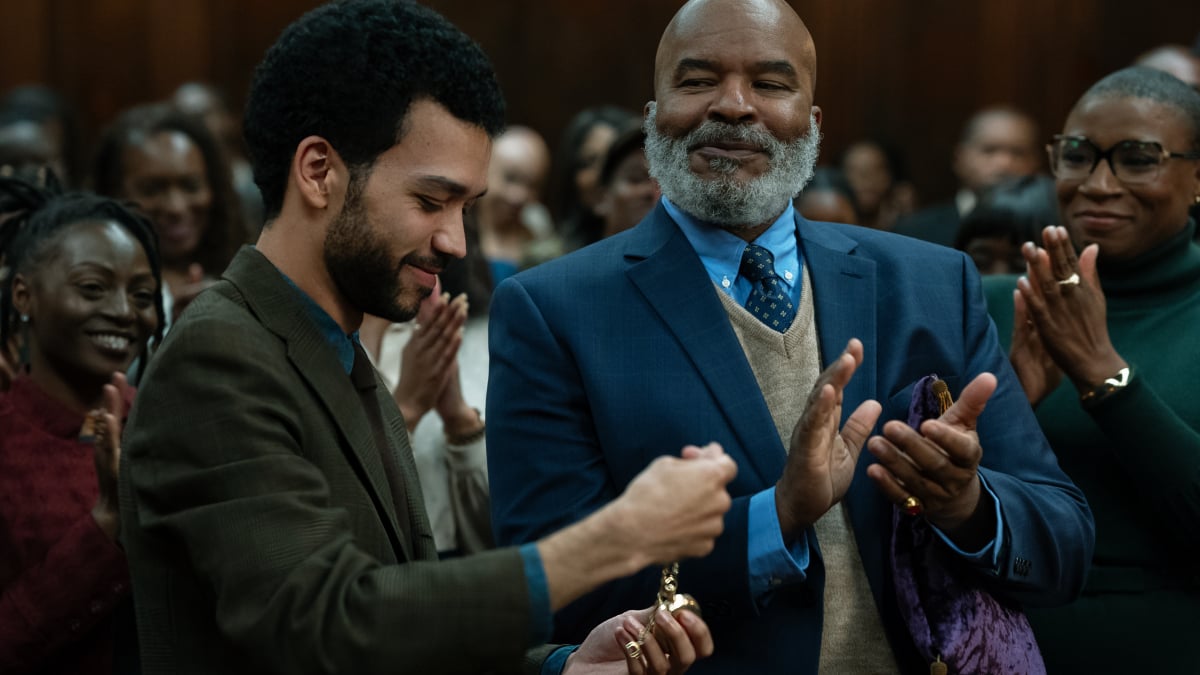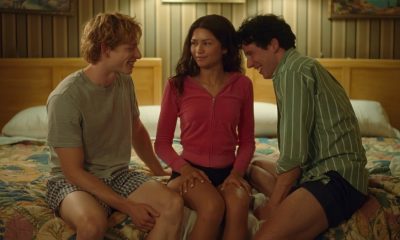Entertainment
‘The American Society of Magical Negroes’ review: A satirical near-miss

The feature directorial debut of comedy writer Kobi Libii, The American Society of Magical Negroes has a fiery premise, but tepid execution leaves its satire feeling lukewarm. However, thanks to an impeccable lead performance from Justice Smith, Libii’s more straightforward dramatic material still manages to strike a chord.
The film’s title echoes a well-worn American media trope — though the term was first coined by filmmaker Spike Lee in 2001, as the “magical, mystical negro“ — which the movie literalizes in tongue-in-cheek fashion. There’s a secret, Hogwarts-esque society of Black cinematic archetypes, and their purpose is to assist white self-actualization. It’s a riotous concept at first, one Libii uses to delve into the psyche of Black protagonist Aren (Smith), as well as into thorny corners of contemporary American politics.
The film’s attention, however, ends up scattered. The further it gets into its 105 minutes, the more it focuses on romantic and workplace issues. These themes are initially bolstered by Libii’s deconstructive satire, but they end up superseding it, becoming the dominant focus in the process. Before long, the interpersonal drama progresses beyond the need for the movie’s comedic premise in the first place, and while it often stands on its own as a rom-com, the satire gradually loses its edge.
What is The American Society of Magical Negroes about?

Credit: Focus Features
Aren, a meek, soft-spoken Black artist traversing white spaces in LA — like art galleries — has trouble standing up for himself, and for the conceptual sculptures he makes from yarn. His timid behavior at a gallery event catches the attention of elderly bartender Roger (David Alan Grier), who follows him home and gets him out of a sticky situation with a magical snap of his fingers and some nifty teleportation.
Roger, it turns out, hopes to recruit Aren to a secret society, whose headquarters he reveals behind the false wall of a barbershop. With its lush, carpeted interiors, and hallways boasting historical portraits, the American Society of Magical Negroes trains young Black initiates to learn the ropes of white appeasement. Their credo stems from the idea that white self-satisfaction ensures Black safety in America, an idea the film dramatizes on Aren’s first assignment.
Roger introduces Aren to a white police officer undergoing a midlife crisis. Pep talks from Aren keep the officer happy and calm, while the alternative — displayed in the form of a magic meter that appears on screen and measures the cop’s bruised ego — is the potential for violent outbursts at some point in the future, as Roger explains.

Credit: Focus Features
The film never depicts the immediate fallout of these dangers — an understandable route to take if a Black filmmaker wants to avoid depicting violence against Black bodies on screen — leaving only Roger’s tenuous descriptions of possible domino effects that might lead to violent outcomes. While the threat of police violence against Black characters hovers over several initial scenes, the line connecting the Society’s mission to preventing these results in the long term is more of a suggestion from Roger. It’s a hypothetical, as though the film were holding a mirror to the kind of respectability politics that positions quiet acceptance as an alternative to revolution, or to even ruffling any feathers.
Through archival clips shown to Aren, projected through magical clouds of smoke, the movie portrays several Hollywood “magical negro” stock types. These examples emerge from across the decades, echoing the likes of the upbeat Uncle Remus (James Baskett) from Song of the South, for whom Jim Crow laws are no match for sagely advice, to Hoke Colburn (Morgan Freeman) in Driving Miss Daisy, who reforms racism with a smile. Some more recent examples, like John Coffey (Michael Clarke Duncan) in Tom Hanks-starrer The Green Mile, even have literal magical powers which they use to heal white characters despite their own suffering, which is ripe for parody in a film like this one. American Society lampoons The Green Mile‘s imagery numerous times through scenes of Black men healing their white counterparts’ sexual anxieties by grabbing their genitals, the way Coffey relieves Hanks’ prison warden of his bladder infection. It’s amusing as a reference, and absurdly funny as an instructional image for Aren to follow.
After an energetic montage — during which Libii’s camera circles Aren as he grows more comfortable and acclimates to the program — the young recruit is given his first long-term assignment: protecting and supporting haughty white tech executive Jason (Drew Tarver, The Other Two). However, after Aren infiltrates Jason’s company and hops aboard as a designer, his objectives becomes complicated once his desires and duties clash: He begins flirting with his mixed-race, white-passing coworker Lizzie (An-Li Bogan), who also happens to be object of Jason’s affections.
The movie’s workplace romance nudges its magical satire off-screen.

Credit: Focus Features
Alluring chemistry between romantic leads is a good problem to have. Smith and Bogan buoy even the movie’s less exciting, less interestingly staged scenes with their cutesy, awkward longing as Lizzie and Aren tiptoe carefully around the boundaries between coworker and friend (and eventually, something more). Add to this the fact that Tarver plays a truly detestable antagonist — a sniveling, easily wounded manipulator who constantly needs his insecurities soothed — and you have the perfect cocktail.
Once Aren begins to juggle his crush on Lizzie with his duty to support Jason, the film primarily becomes about a familiar (and in many ways, realistic) clash between Aren’s work and personal life. Roger keeps adding new mechanics to this tale, but ideas like the whole Magical Society will lose its powers if Aren fails in his duties or acts too selfishly fails to track as a coherent metaphor for the group’s appeasement and assimilation themes.
All the while, Grier still imbues Roger with intriguing pathos as an old-timer who’s seen too many Black people felled by white America (and has himself given up too much in service of saving them) to let Aren sabotage the Society. However, he finds moving familiarity in Aren’s romantic dilemma, and inadvertently makes the romance plot feel more urgent than anything going on behind the barbershop walls. Perhaps spending more time with the actual Society, exploring its mechanics, depicting its magical elements, and laying out the consequences of Aren’s failure might’ve made this part of the movie matter a little more. But luckily, Smith has evolved so much as a performer in recent years — going to from the broad strokes of Detective Pikachu to one of this year’s buzziest festival titles, I Saw the TV Glow — that he practically warps the film around his screen presence, especially in its final act.
Justice Smith delivers a commanding performance.

Credit: Focus Features
The American Society of Magical Negroes falters in too many places to be a biting satire classic, but its one unimpeachable strength is its lead performance. As Aren, Smith rides a delicate line between projecting a cartoonish awkwardness for the back row, and imbuing his hesitant body language with a deep insecurity.
Early in the film, Roger mentions one of the reasons he recruited Aren was the timid way he traversed white spaces, which Aren assures him he’s been doing his whole life as a Black man with a white parent, and a white family. Though we never meet Aren’s family or see him interact with them, Smith folds this element of Aren’s backstory into his performance in minute ways, subtly code-switching and becoming more comfortable with his physicality the closer he grows to Lizzie. Unfortunately, Aren’s lack of interaction with Black characters outside of the Society limits Smith’s ability to fully explore Aren’s shifting comfort in his own skin.
However, after enduring the suffocating workplace mechanics of the tech company — a structure within which Aren has to capitulate to and appease white characters, regardless of his mission — he’s pushed to his emotional limit. This leads to an outburst that clunkily verbalizes the movie’s subtext with all the nuance of an off-the-cuff Twitter thread. Smith is so dialed into Aren’s anger and isolation that he reaches deep down into his gut and retrieves a raw emotional anguish, taking what could’ve been a scene of empty preaching and making it genuinely rousing.
The movie’s funniest, most impactful, and most incisive scenes about the experience of Blackness in America not only unfold far outside the Society’s walls, but outside its fictional confines too. The American Society of Magical Negroes has an ingenious backdrop, but in failing to explore or expand on it, the film sheds the need for its satirical setup in the first place — a sure disappointment to those who, upon the trailer’s release, expressed dismay that a Black fantasy film would rather center white appeasement, rather than a more complete and nuanced set of Black experiences. By the end, the movie’s introspective workplace rom-com works just fine without its magical premise, which feels like a letdown too.
The American Society of Magical Negroes is now in theaters.
-

 Business7 days ago
Business7 days agoThis camera trades pictures for AI poetry
-

 Business6 days ago
Business6 days agoTikTok Shop expands its secondhand luxury fashion offering to the UK
-

 Business7 days ago
Business7 days agoBoston Dynamics unveils a new robot, controversy over MKBHD, and layoffs at Tesla
-

 Business5 days ago
Business5 days agoMood.camera is an iOS app that feels like using a retro analog camera
-

 Business5 days ago
Business5 days agoUnitedHealth says Change hackers stole health data on ‘substantial proportion of people in America’
-

 Business3 days ago
Business3 days agoTesla’s new growth plan is centered around mysterious cheaper models
-

 Entertainment5 days ago
Entertainment5 days agoFurious Watcher fans are blasting it as ‘greedy’ over paid subscription service
-

 Business4 days ago
Business4 days agoTwo widow founders launch DayNew, a social platform for people dealing with grief and trauma




























